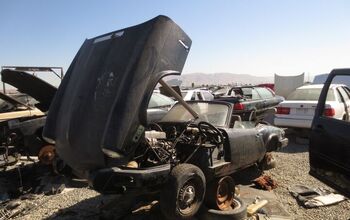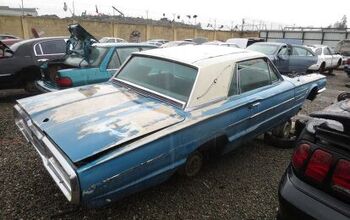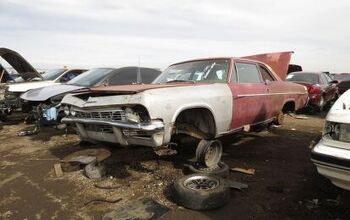Junkyard Find: 1965 Triumph Spitfire

By far the most numerous British sports car in junkyards these days— and, in fact, for the last few decades— is the MGB. We’ve seen many of these cars in this series, but today’s find is just the second Junkyard Find Spitfire, after this ’75. The Spitfire had a long production run, 19 years total, but Spitfires just weren’t anywhere near as sturdy as their MGB cousins and most of the non-perfect examples got crushed long ago. Still, every so often a forgotten project gets evicted from a garage or back yard, and that’s probably what this happened to this battered ’65 that I spotted in a San Francisco Bay Area self-service yard last month.
The Mark 2 Spitfire was built for the 1965 and 1966 model years and was replaced by a version with a 1296cc engine instead of just 1147cc.
There’s not much demand for tiny pushrod engines these days, nor is anyone likely to buy these cute little SU carburetors.
Many, many years in the California sun for this car.
It doesn’t seem very rusty, but Spitfires just aren’t worth enough to make this one worth restoring.
These cars like to break axles, so perhaps some Spitfire owner will pull the ones on this car.

Murilee Martin is the pen name of Phil Greden, a writer who has lived in Minnesota, California, Georgia and (now) Colorado. He has toiled at copywriting, technical writing, junkmail writing, fiction writing and now automotive writing. He has owned many terrible vehicles and some good ones. He spends a great deal of time in self-service junkyards. These days, he writes for publications including Autoweek, Autoblog, Hagerty, The Truth About Cars and Capital One.
More by Murilee Martin
Latest Car Reviews
Read moreLatest Product Reviews
Read moreRecent Comments
- Honda1 Unions were needed back in the early days, not needed know. There are plenty of rules and regulations and government agencies that keep companies in line. It's just a money grad and nothing more. Fain is a punk!
- 1995 SC If the necessary number of employees vote to unionize then yes, they should be unionized. That's how it works.
- Sobhuza Trooper That Dave Thomas fella sounds like the kind of twit who is oh-so-quick to tell us how easy and fun the bus is for any and all of your personal transportation needs. The time to get to and from the bus stop is never a concern. The time waiting for the bus is never a concern. The time waiting for a connection (if there is one) is never a concern. The weather is never a concern. Whatever you might be carrying or intend to purchase is never a concern. Nope, Boo Cars! Yeah Buses! Buses rule!Needless to say, these twits don't actual take the damn bus.
- MaintenanceCosts Nobody here seems to acknowledge that there are multiple use cases for cars.Some people spend all their time driving all over the country and need every mile and minute of time savings. ICE cars are better for them right now.Some people only drive locally and fly when they travel. For them, there's probably a range number that works, and they don't really need more. For the uses for which we use our EV, that would be around 150 miles. The other thing about a low range requirement is it can make 120V charging viable. If you don't drive more than an average of about 40 miles/day, you can probably get enough electrons through a wall outlet. We spent over two years charging our Bolt only through 120V, while our house was getting rebuilt, and never had an issue.Those are extremes. There are all sorts of use cases in between, which probably represent the majority of drivers. For some users, what's needed is more range. But I think for most users, what's needed is better charging. Retrofit apartment garages like Tim's with 240V outlets at every spot. Install more L3 chargers in supermarket parking lots and alongside gas stations. Make chargers that work like Tesla Superchargers as ubiquitous as gas stations, and EV charging will not be an issue for most users.
- MaintenanceCosts I don't have an opinion on whether any one plant unionizing is the right answer, but the employees sure need to have the right to organize. Unions or the credible threat of unionization are the only thing, history has proven, that can keep employers honest. Without it, we've seen over and over, the employers have complete power over the workers and feel free to exploit the workers however they see fit. (And don't tell me "oh, the workers can just leave" - in an oligopolistic industry, working conditions quickly converge, and there's not another employer right around the corner.)














































Comments
Join the conversation
That car doesn't look that bad really It's a round tail which worth a little more. I have seen worse cars than that restored. I have a 76, very basic car and easy to work on. For 76 they upped the CR so remove the smog junk, add a header, twin SU's or a Weber and they don't have problems keeping up. The optional overdrive is nice but I never drive it on he freeway anyways. Most of the problems I see are due to the extra components that were added to the car in later life to keep it federal compliant or make it more marketable. Removing much of that bogus junk keeps it simple. Parts are easy and "cheap as chips" , the nice thing is switches, and stuff like heater valves etc can often be disassembled and repaired. The car will will never be at Pebble Beach, so originality is not really an issue either.
Spitfires may not be worth enough to make this one worth restoring, but I wonder ... what if this Spitfire was given the restomod treatment? Such a project could be along the lines of something like this: http://www.britishv8.org/Triumph/MikeReynolds.htm